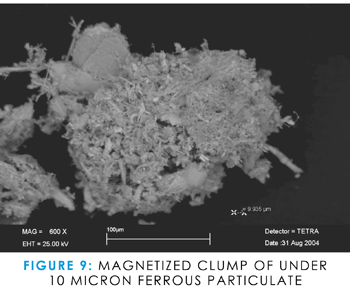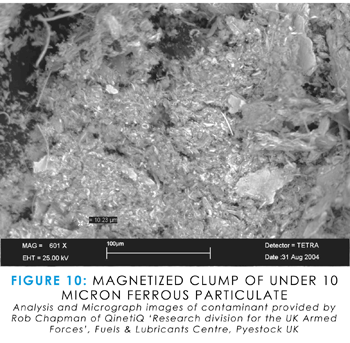INDUSTRY’S ATTEMPT TO DEAL WITH THE GREATEST THREAT
 Historically, the OEM’s and end users of hydraulic systems have recognized the ferrous problem and attempted to deal with it by using one form of magnetic device or another. Attempts to deal with ferrous contaminants in fluids have typically resulted in the addition of some form of magnet inserted into a hydraulic reservoir or even stuck to the inside or outside of the filter housing. Some manufacturers have even inserted magnets into the filter elements themselves. Figure 7 depicts “magnetic filters” in various forms.
Historically, the OEM’s and end users of hydraulic systems have recognized the ferrous problem and attempted to deal with it by using one form of magnetic device or another. Attempts to deal with ferrous contaminants in fluids have typically resulted in the addition of some form of magnet inserted into a hydraulic reservoir or even stuck to the inside or outside of the filter housing. Some manufacturers have even inserted magnets into the filter elements themselves. Figure 7 depicts “magnetic filters” in various forms.
Attempts to deal with this historical problem are represented below in Figure 7. These products serve to demonstrate that a problem has existed and has been identified for many years. The very presence of magnetic devices in hydraulic systems serves to highlight the historical limitations of conventional filtration. Even the most sophisticated hydraulic systems, aircraft and aviation hydraulics, use some form of magnetic filter.
 For example, take the application of a simple magnetic drain plug. Following routine equipment service or a system failure, when the magnetic drain plug is removed, it always has ferrous contamination ‘stuck’ to the magnet.
For example, take the application of a simple magnetic drain plug. Following routine equipment service or a system failure, when the magnetic drain plug is removed, it always has ferrous contamination ‘stuck’ to the magnet.
Historically, magnetic filter designs also fail to meet the specific and demanding requirements of a fluid power environment. Quite simply, they are either random in nature like, “the sump plug” (just radiating and diffusing magnetic flux into a random space) or they are placed directly in often turbulent fluid flow and suffer wash off of contaminant as it builds on the magnet surface.
 The issue is one of simple physics, namely that magnetic energy drops of in strength by the inverse of the cube, over distance. Basically, this means that contaminant has to be very very close to the magnetic source to be attracted and removed. Figure 8 depicts the relationship graphically.
The issue is one of simple physics, namely that magnetic energy drops of in strength by the inverse of the cube, over distance. Basically, this means that contaminant has to be very very close to the magnetic source to be attracted and removed. Figure 8 depicts the relationship graphically.
This is not just about removal of contaminant; it is about retention of the contamination once it has been removed from the hydraulic fluid. Just as conventional filters have issues with particulate retention as shown in Figure 3, so do standard magnets.
Magnetic drain plugs and similar magnetic devices cause many more problems than they actually solve because they suffer from wash off of particles. The contaminant is only influenced by a diffused magnetic flux as there is no concentration or forced direction of the energy. This means that as more particles come in contact with the magnet, the more the particles are located further away from the magnet (or energy source) and as the contaminant grows away from the energy source it eventually washes off.
 Once washed from the magnet, the particles do not drop back into suspension within the hydraulic fluid. Since the particles were exposed to a magnetic field, they remain as a clump, weakly magnetised together. This reality is depicted in Figure 9 and Figure 10 below, and the first component this concentration of high carbon steel reaches often sufferers catastrophic failure, for obvious reasons. This is why catastrophic failures of single components occur in systems that appear to be in perfect condition previously.
Once washed from the magnet, the particles do not drop back into suspension within the hydraulic fluid. Since the particles were exposed to a magnetic field, they remain as a clump, weakly magnetised together. This reality is depicted in Figure 9 and Figure 10 below, and the first component this concentration of high carbon steel reaches often sufferers catastrophic failure, for obvious reasons. This is why catastrophic failures of single components occur in systems that appear to be in perfect condition previously.
Engineers who inspect the components after these system failures see that one component catastrophically failed, while the rest of the components are to specification and within manufacturer’s tolerance. When the failed component is inspected, typically high carbon steel contaminant can be seen imbedded in the softer wear metals close to where the fluid is introduced to the component.
The observance of magnetic sump plug ‘wash off’ creates problems for hydraulic systems. If this observation is coupled with the data from Dynamic Filter Efficiency testing detailing the wash off or perhaps best described as wash through of contaminant in conventional hydraulic filters, this highlights a longstanding problem and provides an interesting challenge when developing a solution.
THE OPTIMUM FORM OF THE SOLUTION
 Given the problems caused by ferrous contaminants in hydraulic systems it made sense to apply some advanced design technigues to a new type of filtration technology. To resolve this historical filtration problem, the weaknesses and strengths of existing filter products and technologies available to the hydraulic system engineer, builder & end user were assessed. Figure 11 shows both the positive and the negative attributes of both the conventional filter element and magnetic device filtration.
Given the problems caused by ferrous contaminants in hydraulic systems it made sense to apply some advanced design technigues to a new type of filtration technology. To resolve this historical filtration problem, the weaknesses and strengths of existing filter products and technologies available to the hydraulic system engineer, builder & end user were assessed. Figure 11 shows both the positive and the negative attributes of both the conventional filter element and magnetic device filtration.
The solution to this historical filtration problem should have all the features in the positive column without any of the negatives to be an effective solution. Using these attributes as a definitive guide, a technology has been developed to effectively eliminate the ferrous problem observed in real life hydraulic systems in the field.
CONTACT
The author has a broad engineering background and trained in the UK. He has owned and run a many successful companies covering a variety of industries. His involvement with the racing industry brought about the innovation and development of the unique MAGNOM Technology now being adopted by the hydraulic and lubrication industries.
Jobey Marlowe, VP Technology
Magnom Corporation
Innovation Centre
Warwick Technology Park
Gallows Hill
Warwick UK
CV34 6UW
Web: www.magnom.com
E-mail: jobey.marlowe@magnom.com
CHECK BACK For Part 2